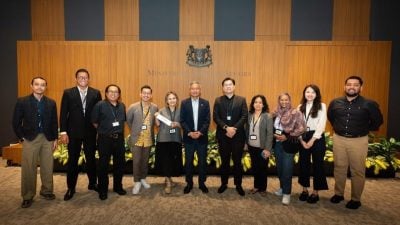
Can there be positive sides to the brain drain? Perhaps. However, not at the scale and the stage as experienced by Malaysia and given its political and governance setup.
In the earlier article “Malaysian Brain Drain – Don’t go chasing waterfalls” from May 25, 2022, EMIR Research made a few critical points encapsulating the Malaysian brain drain problem:
1. The Malaysian brain drain has been growing exponentially over the last four decades.
2. It had a profound negative systemic impact on the nation, including such afflictions as starvation of talent replacement, poor governance and policy-making, middle-income trap, low industry development (less breadth and depth), corruption etc.
3. While facing low industrial development and chronic skills mismatch rooted in the ongoing education system crisis, reverse brain drain (stopping and returning the lost to the foreign lands high-skilled and talented individuals) will become our best bet to jump-start Malaysia’s industry and economy.
4. A complete overhaul of the overall Malaysian setup of governance and policy-making is the single most critical variable to reversing the brain drain.
Yet, some may still express optimism that brain drain is not all bad for the home country, and positive effects may be present.
Impact on ringgit
Can there be a foreign exchange gain for Malaysia because many Malaysians work abroad? As can be extrapolated from the available global statistics, the Malaysia diaspora is about 2 million (see “Malaysian brain drain: Don’t go chasing waterfalls”).
Those working abroad but spending in Malaysia (for example, daily commuters between Malaysia and Singapore) or working and living abroad but sending remittances to Malaysia do contribute to the demand for ringgit.
However, what is the size of this effect? Not the fact that all of them send remittances back home, and even if they do – how much? Is it sufficient to make a sensible impact on the ringgit?
At the same time, let us not forget that Malaysia also has a significant population of migrant labor force, with a historically estimated ratio of at least 1:1 for documented versus undocumented.
With the number of just the documented non-Malaysian workers standing at around 2.1 million in 2020, we can easily picture how the outflow remittance from Malaysia can quickly negate the positive effect of remittance by Malaysian migrants.
On top of that, any negligible positive effect will be further offset by the brain drain’s profound negative impact on the country’s industry and economy, which has a weakening impact on ringgit.
When people of the highest productive and intellectual potential leave the country in great numbers, that country will find it more challenging to maintain a high intellectual and academic standard as these individuals are the vital driving force to create a more educated and professional society, cultivate and develop other talents.
Therefore, this dynamic will create a country’s starvation of talent replacement and further shrink national aggregate creative potential, making the country lose its competitive edge to other more developed nations and slowing down its development and industrialization.
Besides that, persistent highly skilled workers shortage negatively impacts the availability of complementary skilled workers, less-skilled workers, entrepreneurs, and capital providers.
After all, it is the brightest, highly skilled individuals who create new business opportunities in the economy at pace with global industrial development.
At the same time, foreign direct investments are always hungry for home economies whose industries are densely infused with professional and highly skilled individuals, especially in tech as of the latest trend. The need for a highly skilled tech-savvy workforce will only increase in the current, and future global job market as the world is forging ahead with the Industrial Revolution 4.0 (4IR) and soon 5.0 (5IR).
A deficient pool of highly skilled individuals who, among other things, are the key creators of start-ups and a thriving digital ecosystem in the economy significantly shrinks the country’s potential to attract foreign direct investment and, therefore, further economic development.
All the above have a devastating impact on the brain drain’s home currency, and this fundamental incessant weakness is what we see in ringgit Malaysia, especially since 2015.
Rise of remote working
Perhaps, remote working and digitalization could be a positive trend in addressing the talent shortage due to brain drain?
The pandemic has shown us a potential for a hybrid model of remote working, but it might be somewhat limited.
A recent survey by McKinsey of 800 corporate executives worldwide and across all industry sectors found that the potential for remote work, although existent and likely to stay, is highly concentrated among highly-skilled, highly educated workers in a handful of industries, occupations, and geographies.
We need to factor in two aspects while evaluating the potential for remote working.
First is the theoretical potential for work to be done remotely determined by the extent to which there are tasks that require on-site physical presence, use of specialized machinery or equipment or closer, face-to-face, collaboration etc.
The second is effective potential or how much more effectively the work is done remotely as opposed to on-site presence.
Using the above two variables, the McKinsey, for example, found that among the occupations that have the highest potential for remote work are:
- Finance and insurance (76% – 86% of the time can be spent remotely)
- Management (68% – 78%)
- Professional, scientific and technical services (62% – 75%) and
- IT and telecommunications (58% – 69%).
The above are exactly the areas under the hard-to-fill Critical Occupation List by TalentCorp. Therefore, remote working may help Malaysia, at least to some extent, to fill in those hard-to-fill vacancies by TalentCorp.
However, there is one more factor by which we need to multiply the above overall potential – the industry development. The general level of technological advances, innovation and digital transformation in the industry increases the scope of tasks and collaborations that can be done remotely.
Note that we are talking here about digital transformation versus plain digitization. The digital transformation is born when there is the highest level of digitization (conversion of raw facts, events, and physical objects into 0s & 1s) that allows an increasingly larger number of the physical world objects to be placed on the network and moved around while completely re-inventing and re-engineering business processes, business models and business strategies.
Nevertheless, until 2022, when South Korea is already experimenting with the 6G application, Malaysia still has a disjointed digital ecosystem, lack of plain digitalization, and nascent digital transformation.
Therefore, if anything else, the level of digital transformation and remote work potential in advanced countries may increase our brain drain through yet another avenue – remote working.
Of course, these individuals now would be at least staying in Malaysia and spending their money here.
However, we must think broader than that — they will continue to advance somebody’s else economy, not ours, while Malaysia will continue its spiral descent.
(Dr. Rais Hussin and Dr. Margarita Peredaryenko are part of the research team at EMIR Research, an independent think tank focused on strategic policy recommendations based on rigorous research.)
ADVERTISEMENT
ADVERTISEMENT






































